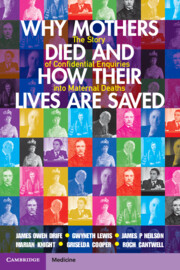 Why Mothers Died and How their Lives are Saved
Why Mothers Died and How their Lives are Saved Published online by Cambridge University Press: 05 April 2023
Obstetric anaesthesia dates from 1853, when John Snow gave chloroform to Queen Victoria. Spinal anaesthesia was described in 1898 but became common only in the 1990s. Nitrous oxide and oxygen ('gas and air') became widely used in the 1960s. The 1930 Report on Maternal Mortality recommended that the same person should not act as anaesthetist and obstetrician. The anatomical and physiological changes of pregnancy increase the risks. In the 1952-4 CEMD Report anaesthesia was involved in nearly 1 in 20 deaths: a major factor was inhalation of stomach contents. The next Report advised tracheal intubation to reduce this risk. The need for an experienced anaesthetist became obvious and in 1969 the Obstetric Anaesthetists’ Association was formed. The 1973-5 Report recognised that anaesthetists require skilled help and later Reports recommended practice drills. In the 1980s there was a move towards regional anaesthesia, first as epidural and in the 1990s spinal anaesthesia. Both require considerable expertise. Improvements in staffing, training and equipment continued, and in the year 2000 anaesthesia was 5 times safer than in 1983 and 38 times safer than in 1963.
To save this book to your Kindle, first ensure no-reply@cambridge.org is added to your Approved Personal Document E-mail List under your Personal Document Settings on the Manage Your Content and Devices page of your Amazon account. Then enter the ‘name’ part of your Kindle email address below. Find out more about saving to your Kindle.
Note you can select to save to either the @free.kindle.com or @kindle.com variations. ‘@free.kindle.com’ emails are free but can only be saved to your device when it is connected to wi-fi. ‘@kindle.com’ emails can be delivered even when you are not connected to wi-fi, but note that service fees apply.
Find out more about the Kindle Personal Document Service.
To save content items to your account, please confirm that you agree to abide by our usage policies. If this is the first time you use this feature, you will be asked to authorise Cambridge Core to connect with your account. Find out more about saving content to Dropbox.
To save content items to your account, please confirm that you agree to abide by our usage policies. If this is the first time you use this feature, you will be asked to authorise Cambridge Core to connect with your account. Find out more about saving content to Google Drive.